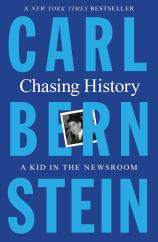Chasing History: A Kid in the Newsroom
Review
Chasing History: A Kid in the Newsroom
Back in the 1980s, there was a recruitment ad for the U.S. Army with the tagline, “We do more before 9 a.m. than most people do all day.”
To paraphrase, veteran newspaper reporter Carl Bernstein saw more landmark events as a teenaged journalist than many did in an entire career.
The erstwhile newsman began his career while still a (struggling) high school student. That’s not to say he wasn’t ambitious and intelligent; he obviously was. He just had no patience for subjects that had no bearing on his world. This would carry over to his college years and have some repercussions, although in the grand scale of things, I can’t imagine how his life’s work could have been substantially improved.
"As a former newspaper writer and editor, CHASING HISTORY was especially personal to me.... [T]o read about the job was quite nostalgic and charming, and proof of what a great responsibility it is to bring the news to the public."
Bernstein is widely known for his takedown of Watergate and Richard Nixon with Washington Post colleague Bob Woodward. But he did not get his start with that august publication. In fact, he began at the bottom with the rival Washington Star as a copy boy at the tender age of 16. Copy boys, as the position was called regardless of the employee’s gender, were responsible for all kinds of errands, sort of an apprenticeship. This was at a time when most major metropolitan areas were able to sustain several newspapers.
An enterprising young man, Bernstein eventually had the opportunity to accompany reporters on assignments in the Washington, DC region. He quickly learned of the racial inequities of the territory, which would stay with him for years as he reported on the murders of African Americans, Freedom Riders and the civil rights era.
Many baby boomers recall where they were when John F. Kennedy was assassinated. They remember the coverage, but I doubt many give a thought to those men and women in the media who actually informed us about that terrible event and the aftermath of grieving. Bernstein was one of those people. Despite his youth --- still not out of his teens --- he pulled somber duty in observing and dictating his impressions over the phone to staffers back at the Star.
A number of the professional procedures Bernstein describes will seem foreign to younger readers who cannot fathom a world without the convenience of cell phones and the internet. “Back in the day,” as the saying goes, reporters had to find pay phones or landlines and consult printed reference materials. Tape recorders were just coming into general use, so they had to master the art of note-taking. To see the author’s details of cars fitted with primitive versions of communications proves just how far technology has come.
Bernstein heaps praise on many of the men and women he encountered at the Star who taught him the ropes, recognized his talents, and offered support and encouragement. It never ceases to amaze me how people of his generation can recall with such clarity situations and even discussions from over 50 years ago.
As a former newspaper writer and editor, CHASING HISTORY was especially personal to me. Of course, I am not comparing myself with this Pulitzer Prize winner in any way. My career in the field was small potatoes compared to Bernstein. But just to read about the job was quite nostalgic and charming, and proof of what a great responsibility it is to bring the news to the public.
Reviewed by Ron Kaplan on March 3, 2022
Chasing History: A Kid in the Newsroom
- Publication Date: January 17, 2023
- Genres: Memoir, Nonfiction
- Paperback: 400 pages
- Publisher: Holt Paperbacks
- ISBN-10: 1250869897
- ISBN-13: 9781250869890




